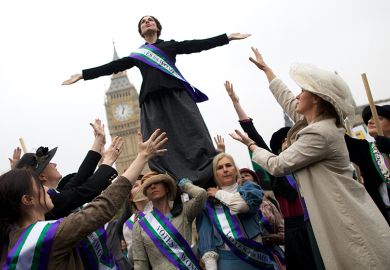She had a curious education, Mary Somerville (1780-1872), whose marble bust, though not her person, was admitted to the Royal Society in 1832. Her father William George Fairfax, later Vice-Admiral, came home from sea when she was ten to find she could barely read. He sent her away to a fashionable school, where she was laced up in stays - she lasted a year. Back home, on the Scottish borders, she was sent to sewing school for reading too much, mostly her brothers' books. At 15 she persuaded her brother's tutor to buy her an algebra book and Euclid's Elements , which she studied by herself, against her father's strictures.
At 23 she married her cousin Samuel Grieg, who also disapproved of intellectual women. Grieg died when she was , leaving her with two children. Now she could read Newton's Principia , study astronomy, and enjoy the intellectual life in Edinburgh.
After five years she married William Somerville, who supported her interests. They moved to London in 1816 - he was appointed principal inspector of the Army Medical Board - and their Scottish connections gave him an entree to scientific circles. Unusually, he took his wife with him. He became a fellow of the Royal Society: she was persuaded to translate Laplace's Mécaniques Celestes into English, and wrote up the mathematical background as a preface.
She was 51 when her Mechanism of the Heavens came out in 1831. It sold well, and was used as a text for advanced courses in Cambridge. To recognise her achievement, Sir Francis Chantrey's portrait bust of Somerville was placed in the Great Hall of the Royal Society. Her reputation transcended that of a populariser of science: she was a scientist, with the imprimatur of her country's Academy of Science. This was seven decades before the first woman, Hertha Ayrton, was put up for the fellowship, and knocked down on the grounds that, as a married woman, she was not, legally, a "person". It was not until 1945 that the first women, Kathleen Lonsdale and Marjorie Stephenson, were elected.
Remarkably, Somerville was a woman that the scientific establishment could accept, indeed, celebrate. On the Connexion of the Physical Sciences came out in 1835, her Physical Geography in 1849, when she was nearly 70.
Kathryn Neeley's book locates Somerville within traditional historical accounts, while recognising her talents. Her self-portrait looks out from the front cover, thoughtful, sensitive. Neeley describes the gender landscape of science in the early 19th century, and Somerville's vision, as "clearly a holistic and multifaceted mode of perception - dynamic, played out through the descriptive patterns of the cosmic platform, tracing the mazes, nature as epic theatre, and the living landscape". Neeley quotes her image of the universe as a musical instrument with gravity resonating through it "like sympathetic notes in music, or vibrations from the deep tones of an organ".
It was said of Somerville that she "did not agitate for women's rights. She took them; one might almost say that she revealed them". But she taught others, such as Ada Lovelace, and she led by example. Hers, by invitation, was the first signature on John Stuart Mill's petition for women's suffrage.
Joan Mason was formerly reader in chemistry at the Open University. Her research on women in science includes writing on Rosalind Franklin for the Jubilee year 2003 founding chair of the Association for Women in Science and Engineering.
Mary Somerville: Science, Illumination, and the Female Mind
Author - Kathryn Neeley
ISBN - 0 521 62299 9 and 62672 2
Publisher - Cambridge University Press
Price - £40.00 and £14.95
Pages - 263
Register to continue
Why register?
- Registration is free and only takes a moment
- Once registered, you can read 3 articles a month
- Sign up for our newsletter
Subscribe
Or subscribe for unlimited access to:
- Unlimited access to news, views, insights & reviews
- Digital editions
- Digital access to THE’s university and college rankings analysis
Already registered or a current subscriber?



